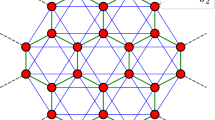Abstract
Quantum Systems modeling and simulation activity is a challenging research area. Several models and applications were proposed in the past with different approaches. Special purposes models based on Cellular Automata (CA) paradigm were studied as the classical CA present limits in quantum system characterization. In this paper we derive a basic qualitative model, according to the Cellular Automata Network Model version 2 (CAN2), for studying and characterizing a frustrated liner JJA, showing that, when adopting particular system conditions, the corresponding model is extremely simple, and each component characterizing system can be easily individuated.
Access this chapter
Tax calculation will be finalised at checkout
Purchases are for personal use only
Preview
Unable to display preview. Download preview PDF.
Similar content being viewed by others
References
Aharonov, Y., Casher, A.: Phys. Rev. Lett. 53, 319 (1984)
Blanter, Y.M., Fazio, R., Schon, G.: Nucl. Phys. B S58, 79 (1997)
Blatter, G., Geshkenbein, V.B., Ioffe, L.B.: Phys. Rev. Lett. 63 (2001) 174511
Calidonna, C.R.: The CAN2 model: a CA hybrid model derived by micro and macroscopic complex phenomena empirical observation. Submitted to ACRI 2004 (2004)
Di Napoli, C., Giordano, M., Mango Furnari, M., Mele, F., Napolitano, R.: CANL: a Language for Cellular Automata Network Modeling. In: Proc. of Parcella 1996 – Seventh International Workshop on Parallel Processing by Cellular Automata and Arrays, pp. 16–20. Springer, Berlin (1996)
Doucot, B., Feigelman, M.V., Ioffe, L.B.: Phys. Rev. Lett. 90, 100501 (2003)
Ekert, A., Jozsa, R.: Rev. Mod. Phys. 68, 733 (1996)
Galindo, A., Martin-Delgado, M.A.: Rev. Mod. Phys. 74, 347 (2002)
Goldobin, E., Koelle, D., Kleiner, R.: Phys. Rev. B 66, 100508(R) (2002)
Kitaev, A.: Annals pf Physics 303, 2 (2003)
Ioffe, L.B., Geshkenbein, V.B., Feigelman, M.V., Fauchère, A.L., Blatter, G.: Nature 398, 679 (1999)
Ioffe, L.B., Feigelman, M.V.: Phys. Rev. B 66, 224503 (2002)
Lent, S., et al.: Quantum Cellular Automata. Nanotechnology 4, 49 (1993)
Orlando, T.P., Mooij, J.E., Tian, L., van der Wal, C.H., Levitov, L.S., Lloyd, S., Mazo, J.J.: Phys. Rev. B 60, 15398 (1999)
Petitot, J.: Centrato/a-Centrato. Enciclopedia Einaudi, vol. 2 Einaudi, Torino, Italy, 894–954 (in Italian)
Rotoli, G.: Phys. Rev. B 68, 052505 (2003)
Shnirman, A., Schon, G., Hermon, Z.: Phys. Rev. Lett. 79, 2371 (1997)
T’Hooft, G.: Can Quantum Mechanics be reconciled with cellular Automata? Int. Jour. Theor. Phys. 42, 349 (2003)
Wen, X.G., Niu, Q.: Phys. Rev. B 41, 9377 (1990)
Wen, X.G.: Phys. Rev. B 44, 2664 (1991)
Weimar, J.R.: Simulation with Cellular Automata. Logos Verlag, Berlin (1997)
Worsch, T.: Simulation of Cellular Automata. Future Generation Computer Systems 16, 157 (1999)
Author information
Authors and Affiliations
Editor information
Editors and Affiliations
Rights and permissions
Copyright information
© 2004 Springer-Verlag Berlin Heidelberg
About this paper
Cite this paper
Calidonna, C.R., Naddeo, A. (2004). A Basic Qualitative CA Based Model of a Frustrated Linear Josephson Junction Array (JJA). In: Sloot, P.M.A., Chopard, B., Hoekstra, A.G. (eds) Cellular Automata. ACRI 2004. Lecture Notes in Computer Science, vol 3305. Springer, Berlin, Heidelberg. https://doi.org/10.1007/978-3-540-30479-1_26
Download citation
DOI: https://doi.org/10.1007/978-3-540-30479-1_26
Publisher Name: Springer, Berlin, Heidelberg
Print ISBN: 978-3-540-23596-5
Online ISBN: 978-3-540-30479-1
eBook Packages: Springer Book Archive




